My first photo was terrible, yet diagnostic for reporting purposes. I finally caught it on May 29 as it peeked out from behind the dense foliage:
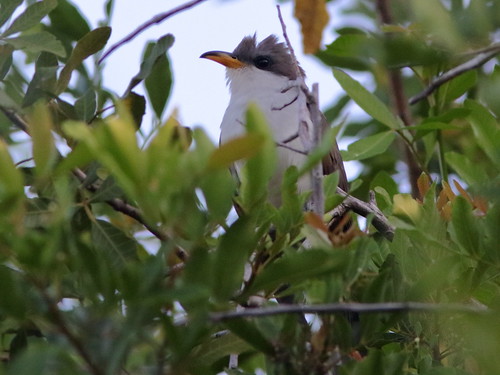
My initial open shot was on May 31, when one called from the branches of a dead tree not far away. It was badly back-lit. Note its yellow bill and the six distinctive white spots under its long tail:

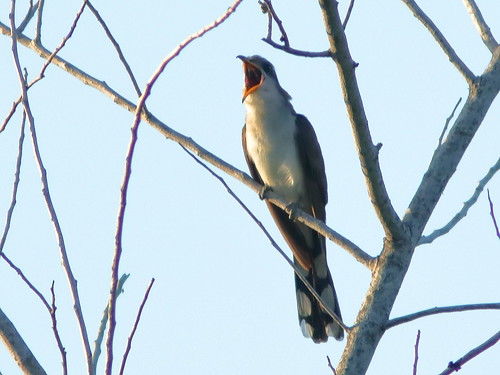
On June 1 I snapped a couple of poor photos from far away as it appeared briefly and then launched into flight. We have only two cuckoo species in the USA, the Yellow-billed and the Black-billed Cuckoo. The second photo illustrates the chestnut reddish brown flight feathers which also distinguish it from the Black-billed species:


On June 4 I followed one along a row of trees until finally getting a rather distant shot. Luckily, the sunlight was nearly perfect to show off its wing feathers:
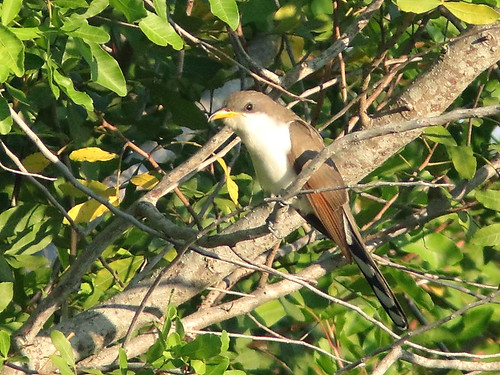
Look closely at its toes and see that, like all cuckoos (as well as owls and woodpeckers), it has zygodactyl feet, with two toes pointing forward and two to the back:

Our cuckoos are related to the European Common Cuckoo which is an obligate brood parasite, meaning that it must lay its eggs in the nests of other species in order to reproduce. Both of the New World cuckoos are facultative brood parasites which sometimes do this but mainly build and tend their own nests and eggs.
Yellow-billed Cuckoos are declining in number, especially those in the western US which are classified as Threatened under the Endangered Species Act. They no longer breed in British Columbia, and the California population of breeding pairs has declined from 15,000 to only about 40 pairs in less than a century.
My first encounter with the Yellow-billed Cuckoo was as a kid in New Jersey. I saw it eating tent caterpillars and later found its nest. It contained eggs, which I photographed with a Brownie box camera and waited anxiously for the roll of film to be developed. They were out of focus and I cannot remember whatever came of them.
These are photos of the Black-billed Cuckoo which I took in NE Illinois in May, 2011:

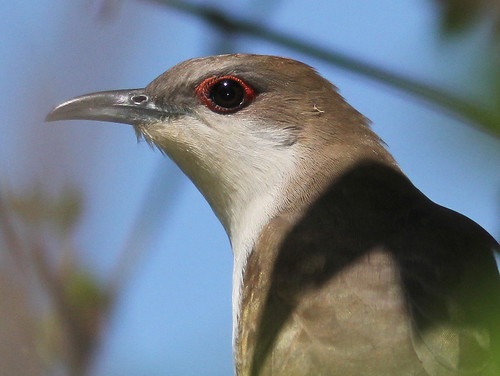
This is the trail along the canal where I have seen the cuckoos, just after sunrise on June 6:
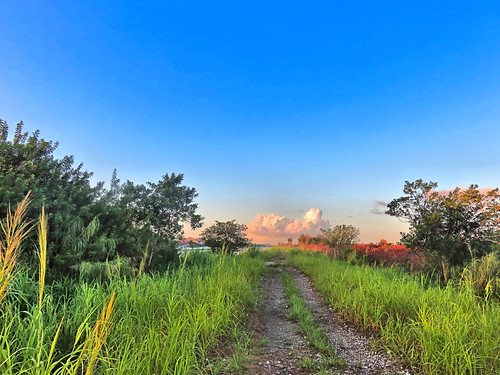
Note the storm clouds on the horizon. We have settled into the summer pattern of hot and humid mornings followed by afternoon showers and thunderstorms. Cuckoos have been called "rain crows" as they are said to be more vocal on cloudy days. Indeed, this was the scene from our back yard on June 3, one of the days I heard it calling:

= = = = = = = = = = = = = = =
Linking to Misty's CAMERA CRITTERS,
Linking to Eileen's SATURDAY'S CRITTERS,
Linking to SKYWATCH FRIDAY by Yogi, Sylvia and Sandy
Linking to WEEKEND REFLECTIONS by James
Linking to BirdD'Pot by Anni
Linking to Our World Tuesday by Lady Fi
Linking to Wild Bird Wednesday by Stewart
Linking to Wordless Wednesday (on Tuesday) by NC Sue
Linking to ALL SEASONS by Jesh
Linking to Fences Around the World by Gosia
________________________________________________
Please visit the links to all these memes to see some excellent photos on display
________________________________________________
How wonderful that you have seen this Cuckoo on your patch Kenneth. That last shot is a great reflection image. I hope you have a lovely weekend.
ReplyDeleteLovely captures, and critters.
ReplyDeleteWow, the double rainbow is beautiful. What a lovely sighting. The Cuckoo are great birds, great photos. Enjoy your day, have a happy weekend ahead!
ReplyDeleteGorgeous photos as usual - love the storm clouds and rainbow especially!
ReplyDeleteThose birds look beautiful and at peace! They seem to love being photographed :)
ReplyDeleteThat's an impressive list of bird sightings. Beautiful rainbow capture!
ReplyDeletemagnificent feathered friends shots! and the iconic rainbow is beautiful ~
ReplyDeleteHappy Day to you,
A ShutterBug Explores,
aka (A Creative Harbor)
Lovely cuckoo shots and I love the rainbow. Have a good weekend, it is nearly here, Diane
ReplyDeleteBeautiful rainbow.
ReplyDeleteRainbow is stunner
ReplyDeleteGreat shots! I hope the California birds can recover their population. I had a Brownie camera too, and it was not suited for close up shots.
ReplyDeleteBeautiful birds. I like the close up shot of the cuckoo. My favourite is the one with the double rainbow. Happy weekend!
ReplyDeleteGreat catch on the rainbow reflection shot. Enjoy seeing your bird photos.
ReplyDeleteI love these photos of the cuckoo. We live in north central Florida, in the Ocala National Forest. I don't believe I've ever seen a cuckoo in this area, so this is fascinating. Thank you for sharing it with us. Yes, we are getting the afternoon showers now also, and we are so thankful for them.
ReplyDeleteWow!!! In the Netherlands it is already lucky when you see a cuckoo but you immediately show a beautiful series of this beautiful cuckoo.
ReplyDeleteReally pretty.
Greetings, Helma
Hello, great shots of the Cuckoo. I have only seen the Yellow-billed Cuckoo, they are cool birds. Now, I need to find the Black-billed Cuckoo. Pretty rainbow, lovely photos. Thanks for linking up and sharing your post. Happy Saturday, enjoy your day and weekend. PS, thank you for leaving me a comment on my blog.
ReplyDeleteWhen I was hiking at Ross Prairie a few years ago, a lady told me where she had seen Cuckoos! I was so excited but I still haven't seen one that I know of! You always take the most beautiful photos!
ReplyDeleteFantastic shots of the Cuckoo. Not a species that we get here in the UK.
ReplyDeleteWhat a beautiful rainbow! Great reflection!
ReplyDeleteI've seen them locally, but not often. Love your photos! Didn't know about the reference to "rain crow"...interesting.
ReplyDeleteThanks so much for linking in at I'd Rather B Birdin' (hope you had a great Father's Day)
Hope the hiccups of the linkylist are temporary in nature! That is quite an accomplishment to have seen this many birds! No question about it, you are heavily into birding:) Interesting development that the cuckoos are declining in rate so much! Many thanks for your interesting post for All Seasons and have a great birding week!
ReplyDeleteAlways good to find a new bird - interesting about the obligate / facultative aspect - did not know some cuckoos could choose.
ReplyDeleteCheers - Stewart M - Melbourne
No cuckoos here - so glad to have seen them through your photos.
ReplyDeleteThanks for linking up at https://image-in-ing.blogspot.com/2019/06/classical-art.html
Fine shots of the cuckoo and the rainbow is gorgeous.
ReplyDeleteThe Creator thought of how practical Zygodactyl feet are, great to grip around a branch:) Many thanks Ken, also for the beautiful butterfly for 90 Days of Summer, as well as your comment of the difficulty painting water. Don't have much experience with that focus:)
ReplyDelete